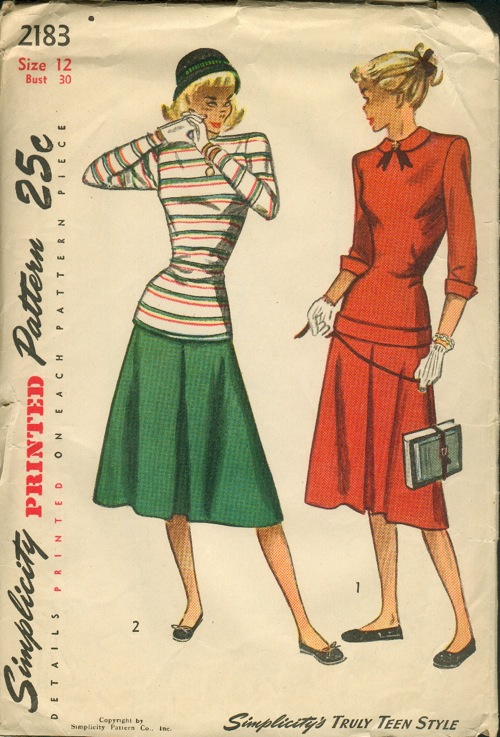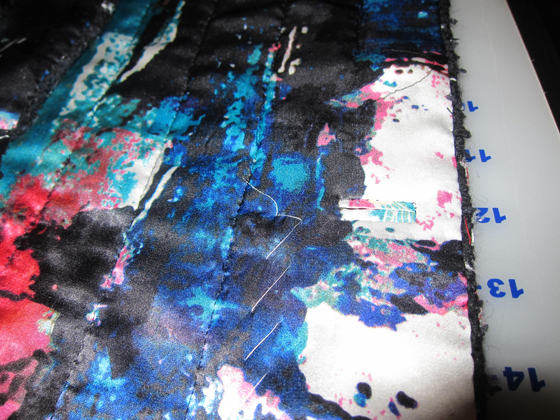I made them because I wanted a bouclé cape with real buttonholes instead of the easier hook and eye. A hand-worked buttonhole is made on the face fabric (= bouclé), and a faux bound buttonhole is done on the lining, which extends to the edge of the jacket.
Claire Shaeffer is the only one who describes this technique en detail - see the end of this post for available sources. So, I followed her instruction, changing a few things, which I thought made sense to me. Here I am describing how I did it.
Time spent: appr. 30 min per buttonhole (2 hours in total)
Materials used:
- silk thread for basting
- polyester thread for permanent stitching
- longer Japanese needles for basting
- shorter Japanese needles for permanent stitching
- Iron
Techniques:
- running stitch
- slip stitch
THE STEPS:
1. Prepare buttonhole welts
To prepare buttonhole welts, tear couple of 1 inch (2.5 cm) - wide strips of lining remnants on crossgrain. If your fabric doesn't allow tearing then cut on grain.
I find that tearing the strips not only precisely establishes the grain, but also simplifies pressing and aligning of the strips in the following steps.
You will need 2 welts for each buttonhole, and to establish the welt length use the following formula:
welt length = buttonhole length + 1" (2.5) seam allowance
Don't cut your stripes into welts yet, just use this formula to establish the total length you will need. it will save you some time.
2. Press welts
Press your stripes to flatten the torn edge. Fold stripes in half, wrong sides together, and press them again.
3. Cut welts
Now cut the welts in the required length using the formula above.
4. Place the welts on the face fabric
It helps, before you do this step, to secure the hand-worked buttonhole on the face fabric (image above). This will minimize shifting of the fabric layers and allow you to align the welts faster.
Place the welts on the wrong side of the garment, with folds facing each other along the buttonhole centerline. It helps if the line is thread traced on the face fabric - it is usually done before the hand-worked buttonholes are applied. This thread-traced line should extend more than 1/2 inch on each side to serve as a guide.
Using a small running stitch, permanently stitch the welts to the face fabric.
5. Finish lining
Lay the lining over the buttonholes and finish it. Usually, in this type of garment, where lining is quilted to the face fabric, it extends almost to the edge, and is finished using fell-stitches.
6. Secure lining around buttonholes
 |
| Here you see how I basted around the buttonhole (from the right side of the garment) and, then, outlined the buttonholes lines (Step 7) |
Before you proceed, you will need to secure the lining in place - this will allow you to cut the buttonhole with minimal shifting. To secure the lining baste around the buttonhole using a running stitch. Silk thread is the best, of course, since it doesn't leave marks on lining.
This is where the easy part ends, readers. You will need to be extra focused
7. Clip the lining
As next, Claire Shaeffer advises to "carefully mark the ends of the buttonhole with pins and carefully clip between the pins, and another 1/16 inch at each end."
Be careful here! Since you basted the lining to the face fabric you have no control over the welts sandwiched in between, so, you have to be extremely careful about not clipping the welts accidentally.
When I did the trial buttonhole, I clipped the center line wrong, so it was off. With the next buttonhole, I used an air-erasable marker to draw the center line and the outlines.
8. Finish the buttonhole
To finish the buttonhole you will need to carefully turn under the buttonhole edges appr. 1/8 inch from the centerline and slipstitch the folded edges to the welts. This is probably the most demanding step as it requires very accurate folding and stitching.
I would recommend using a smaller hand sewing needle and going around the buttonhole twice - this way you don't have to make too tiny stitches. Claire Shaeffer also recommend using needle point to shape the buttonhole corners.
By the way, you can see that my buttonhole welts are wider than 1/8 inch. I just thought this would work best for me, mainly because I used relatively large buttons, so the buttonhole length is slightly more than an inch. I think solid color would look better with narrower welts.
It is virtually impossible to achieve perfect rectangular shape with charmeuse, because it is so slippery and frays the moment you touch it. Now, I think fusing around the lining around the buttonhole may help control the silk. However, with silk, I would be extra careful about it and make a sample first. I would also secure the corners with a couple of narrow overcast stitches, because those sections are under the stress every time you (un)button the jacket.
So, that's it readers!
Am I happy with the outcome?
Well, I wish the result was better, but then I looked at pictures of vintage couture Chanel jackets available on Shaeffer's DVD "Behind the Seams: Shaeffer on Chanel". Readers, hand-worked buttonholes look better than mine, but not better than Jefferey D.'s. However, the faux bound buttonholes are often a mess, at least judging by those pictures - I think, with some experimenting it is possible to achieve better results.
The verdict:
Shaeffer's technique is the most suitable technique for bouclé jackets. Finishing part is really awkward, but if you are a patient person and don't mind going slowly about it, you will get quite good buttonhole.
Some tips on how to make it look even better:
Mastering hand-worked buttonholes is important for the overall outcome. However, I also realized that bouclé hides a lot of imperfections. Choosing silk thread for the face fabric will blend threads even more. Using quality beeswax helps as well, as the thread will look less dull.
With the faux bound buttonholes, I thought that print charmeuse (instead of the solid color) is more forgiving, especially if it is an abstract print like mine.
Finally, applying some pressure to the buttonhole with the tip of an iron makes it look better.
As for the cape, it is now finished, yay! I may also apply chain to weight it in front, because it pulls back slightly, maybe because of the heavier slit on the back. I am still not decided on it... Will be posting the pictures of the finished cape this week, readers!
Here are some sources I used as a reference:
V8259 - highly coveted jacket pattern by Claire Shaeffer Custom Couture (inspired by a strikingly similar vintage couture Chanel jacket). Construction technique include quilting and a three-piece sleeve.
"The Comfortable Side of Couture: Practical Techniques of Coco Chanel" by Claire Shaeffer in
"Great Sewn Clothes", Threads publication - describes construction techniques of a typical couture Chanel jacket
"
The Comfortable Side of Couture:Practical Techniques of Coco Chanel" by Claire Shaeffer in
Threads Magazine Archive, Issue 23, June/July 1989
What about your buttonholes? Have you tried buttonholes on bouclé, or any other loosely woven fabrics. I am wondering what other options are there... as always post links to relevant posts, projects, tutorials!




































